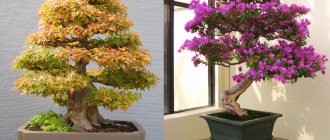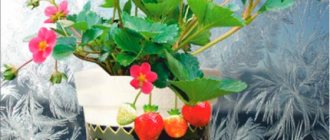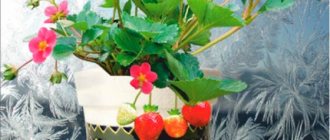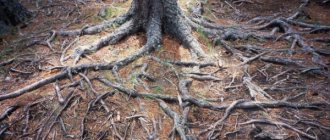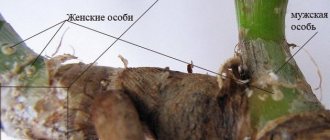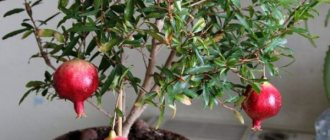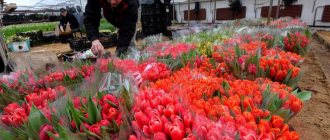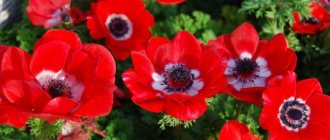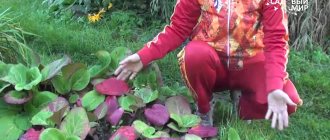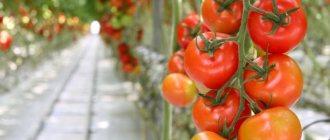Bonsai is a gardening art whose purpose is to grow a decorative miniature tree. Imagine pine, cedar or maple growing in a small pot on the windowsill!
The hundred year old maple and scarlet begonias look amazing!
This art appeared in Japan more than 2 thousand years ago, then migrated to China, and about a century ago it became popular throughout the world. Let's talk about how to grow bonsai, how to choose a plant, soil, pot, how to form a crown, etc.
How to choose a plant for bonsai
You can grow bonsai of any type: all deciduous and coniferous trees, flowering or decorative deciduous. Any of them will (and should) repeat the natural cycle. The best choice is plants with small leaves and a lot of branches.
Typically, a bonsai tree is no more than half a meter in height. And superminiature ones can be up to 3 cm. Huge bonsai are only 150 cm and no more
There are specific species recommended for bonsai:
- Japanese quince, wild, Chinese;
- hawthorn;
- small-leaved elm, squat;
- Canadian spruce, common;
- common larch;
- Chinese juniper;
- aspen;
- ficuses (almost all, but the best is Benjamina);
- small-fruited apple tree (may have red or green leaves), wild;
You can keep bonsai both in the house and in the garden. Choose a location for each individual. It is not recommended to change it.
Every season has its own charm
Please note that deciduous plants will change color and shed leaves in the fall, and bud and bloom in the spring. If you don't want to see bare branches in winter, choose something evergreen. For example, conifers or other evergreen species.
For beginners, the best choice is ficus benjamina. It grows quickly, has small shiny leaves and a trunk that thickens on its own. Already at 5 years it will look like an old tree.
Form your first bonsai from ficus benjamina
At the same time, you can try to grow a coniferous or deciduous seedling. At the same time you will understand the difference.
Choosing the right tree for bonsai
What types of plants are suitable for bonsai, Japanese style tree? To quickly get an attractive tree, you can pay attention to:
- for indoor varieties of citrus fruits, for example, calamondin or regular lemon;
- for dwarf pomegranate;
- to the incredibly common and unpretentious Ficus Benjamin;
- for decorative varieties of apple trees;
- on the willow;
- on low-growing pines;
- for a wide variety of maple species.
The choice of trees suitable for bonsai is incredibly large, and many of them are indigenous to Russia and are found in gardens, parks, city squares and forests. Magnificent compositions are obtained from barberry and serviceberry, hawthorn, acacia and birch, elderberry and linden, euonymus and oak.
Before growing a bonsai, based on the type of plant, its future height and style are determined.
Bonsai styles
This art is more than two thousand years old, so there are more than two dozen main styles alone. The very first thing to do is to choose the style in which you will form your miniature tree.
Basic Bonsai Tree Styles
Please note that styles differ not only in the presence or absence of a slope, the number of trunks, but also in the location of the main branches. If you like a particular style, find its detailed description and several photographs. All this will be required when forming the trunk and crown.
And these are not the smallest ones
There is also a division of bonsai trees by size. There are five main classes, and three of them also have gradations. The sizes of bonsai trees are shown in the table below. There are also Russified analogues of Japanese/Chinese names.
| Class | Subclass | Bonsai tree height | Russian name | Bonsai Pot Dimensions |
| Mame | Keshi-Tsubu | less than 2.5 cm | Tiny | 3-8 cm |
| Sieve | from 2.5 cm to 7.5 cm | 5-10 cm | ||
| Gafu | from 8 cm to 3 cm | 10-15 cm | ||
| Sehin | Komono | from 13 cm to 17 cm | Small | 12-20 cm |
| Myabi | from 18 cm to 25 cm | 15-25 cm | ||
| Kifu | Katade Mochi | up to 40 cm | Average | 25-46 cm |
| Tyu/Tyukhin | Katade Mochi | from 40 cm to 60 cm | Big | 40-90 cm |
| Omono | from 60 cm to 120 cm | |||
| Dai/Daiza | Bonju | more than a meter | Huge | 75-125 cm |
Frequently asked questions and answers
Why does a bonsai shed its leaves?
The reason may be untimely tree replanting. Frequent watering and a lack of microelements in the soil, poor quality water provoke dryness, yellowness and falling of bonsai foliage. Trees also often suffer due to improper light conditions and dry air.
Why is bonsai small?
For bonsai, ordinary trees are used, they are kept small thanks to constant pruning and various other methods. At the same time, the ratio of the sizes of the root system, limited by the volume of the bowl, and the ground part of the bonsai corresponds to the proportions of an adult tree in nature.
Techniques (methods) for growing them
Next, we decide on the start. There are three techniques for growing bonsai trees:
- from seeds (it will take 12-15 years to form a bonsai-like plant);
- from seedlings (minimum period - 5-7 years);
- cuttings (some species will look like bonsai after 4-5 years).
Advice for beginners: form one or two seedlings, and grow another ten, twenty or thirty.
With any growing method, the plant in the “starter” pot is grown to the desired height. The formation of the crown and bending of the trunk occurs while the “blank” is growing. A ready-made mini-tree that has finished growing is transferred to an “adult” pot.
What to do with the seeds
If you decide to germinate from seeds, place them in a container with moss for the cold season and place them on the bottom shelf in the refrigerator. Until spring. Cold temperatures prepare the seed to grow as the weather warms. This process is called stratification. In the spring, plant the seeds in the ground, keep the soil slightly moist, but do not let it sour. Sprouts will quickly appear and immediately begin to grow.
Seeds can be germinated in egg trays
Stratification is necessary for plants in our climate zone. Germinate tropical tree seeds after soaking them in water for 24 hours.
The hatched seeds are watered and left to grow. When they are more than 10 cm high, you can transfer each one to its own pot, wait a couple of months until they take root, and begin formation.
Choosing seedlings
Grow a bonsai from a seedling faster. They are planted in the fall. It will be much easier if you buy a selected and prepared plant in a specialized store or garden center.
In general, seedlings can be found in the forest, but it is better on a roof, on a rock or a fence. Where there is not enough soil. The plant should be no more than 15-20 cm high. It is desirable that it already has enough lateral branches.
Seedlings can be bought at a specialty store or found in the forest. To make it clearer what to choose, the right one at the plate is simply perfect. Cut off the excess during the formation process and get a decorative crown
If you dig, grab some of the “native” soil - adaptation will be easier. Allow the plant to take root in the pot until spring.
Bonsai cuttings
You will have to take cuttings for exotic plants such as ficus, figs, tea tree, etc. They are cut off in the spring from mature plants (before young buds appear) from the trunk itself. The length of the cutting is about 25 cm. Ideally, there should be several side branches. We cut off the upper, too soft part of the cutting parallel to the ground. We also cut off the lower one, which is too hard, but at an angle. We remove the lower leaves; if there are large ones, cut off most of them, leaving half a leaf.
Cuttings must be strong
Dip the bottom cut into the rooting agent.
Phytoclon - an effective gel for rooting plant cuttings
The cuttings can be kept in water until roots appear or immediately planted in a clay pot (regular) with ordinary garden soil. The cut should be deepened by 5-7 cm. Place the pot/jar with cuttings in the shade and water regularly. When new leaves appear, gradually move the pot to a more illuminated place, but not into open sun. Feed once a month. Grow the seedling for a year or two until it reaches the desired height.
Types and techniques
There are different types of bonsai, but they are all grown using two techniques:
- Traditional.
- Special.
Today, special techniques are less popular than traditional ones. Only knowledgeable gardeners use it. It involves growing bonsai in styles such as miniature landscape, common roots, wind-blown, and rock-grown. Each of these styles has its pros and cons, but not everyone can master them.
Traditional technology is used as the main one by almost all amateur gardeners. It also includes several different styles, including group, oblique, half-cascade, cascade, literary, straight formal, straight informal and composition.
The variety of types and subspecies of bonsai is amazing. Plants are grown from both seeds and cuttings.
Bonsai pot
If you look at different photos, all mini-trees grow in wide and flat pots. And this is no coincidence. It is by limiting the growth of the root system in depth that the growth of the above-ground part is inhibited. You need to find such a bowl - wide, with low sides. The best one is ceramic. Ideally, in general, stone. Approximate pot sizes for each class of bonsai tree are given in the table above.
Plant seedlings in wide and flat pots and bowls
A bonsai pot should have several drainage holes. Ideally, they are located two on each side. A wire is threaded through them, which is used to fasten the plant.
Please note that when transplanting, the pot is not changed. When growing (accelerating), a “starter” pot is used. This is still not a bonsai, but only a preparation for it. The mini-tree will spend the rest of its life in the same pot.
Preparing a Bonsai Pot
Since there is little space for the root system, the roots grow into holes for water drainage. To prevent this from becoming a problem, secure a piece of garden net over the hole. It can be glued with silicone or fixed with a piece of wire, as shown in the photo above.
Description
Bonsai is a concept that implies the cultivation of miniature copies of trees using a special technique. Such plants look very beautiful in pots and help create a cozy atmosphere in the room.
Bonsai cultivation first began in China due to the decree of the emperor, who ordered the creation of an exact copy of the Chinese empire, including plants and trees. A method was invented that made it possible to grow ordinary trees in a reduced form, which has since become very popular not only in China, but also beyond its borders.
You can learn more about growing bonsai from our article, where you can also find step-by-step instructions and an interesting video about the types and techniques of cultivation.
The soil
You will have to prepare the soil for growing a bonsai tree yourself. The recipe depends on the type of plant. For tropical species, take the following composition:
- river sand (coarse) - 40%;
- garden soil - 30%;
- organic fertilizer - 20%;
- crushed peat - 10%.
Soil is important for normal growth.
For plants in our climate zone , we take 3 parts of garden soil, 1 part each of sand and peat. These are approximate proportions that can be adjusted. For example, for those plants that grow best in sandy soils, use more sand than garden soil.
When does a plant need to be replanted?
DIY drainage for indoor plants
If the bonsai grows in open ground, it does not need to be replanted, but in a limited volume, replanting is necessary so that the roots do not intertwine. This procedure is considered planned, that is, it occurs regularly at a scheduled time and depends on the age, size of the tree and pot, as well as the type of plant and nutrient soil.
For your information! Young plants, no older than 4 years, are replanted every spring, when the growing season begins, adult plants - once every 10 years. The signal for replanting is roots sticking out of the drainage hole and leaves starting to fall off.
There is another type of transplantation - emergency, it is carried out when the plant is sick or the roots have rotted.
Bending and shaping
To give the tree the desired shape or slope, use thick aluminum or copper wire. It is wound around the trunk and branches. All that exist at the moment or only those that need to be “moved” or bent.
One of the techniques for forming a bonsai tree. This birch is one of the most flexible plants
They usually start from the trunk. They start from the roots, moving to the top. Then they move on to the branches. If you don't want wire marks left, don't wrap it too tightly. Once the wire is in place, slowly and smoothly bend the plant into the desired shape. Sometimes, to hold the barrel, you have to wind a double helix.
For beginners, the best tactic is to choose a sample and strive to repeat it
Bend coniferous plants especially carefully. For them, it is necessary to begin formation already in the first/second year. Therefore, take young seedlings or two-year-old cuttings. When growing bonsai from spruce, cedar, larch and pine, shape the branches immediately after the growth of young shoots stops. Partially cut them off, wrap the remainder with wire and direct them in the desired direction.
The wire is removed only after the trunk and branches have completely hardened and taken the desired shape
With wire you keep plants for six months or more. At this time, water it regularly and feed it with fertilizers for the species being grown. Then you can remove the wire and transfer the plant to the “main” pot.
Crown shapes
Automatic watering for indoor plants - do it yourself
Shapes (styles) of crowns for bonsai:
- fan;
- formal vertical;
- informal vertical;
- inclined;
- cascade;
- semi-cascade;
- Bohemian;
- tree bent by the wind;
- double barrel;
- multi-barreled;
- grove or group planting;
- roots on a rock;
- tree on stone;
- fallen tree;
- dead wood.
Trimming
Pruning a bonsai tree is an ongoing process. The primary is done before applying the wire. Cut off all unnecessary branches, wait until the cuts are healed (the juice will stop secreting and the bark will grow). Now you can wind the wire. In the future, with the help of pruning, you maintain the crown of the required shape and size, cutting off everything unnecessary. During the growing season, you may need to cut off the excess once a month.
To prevent infection when cutting branches, use sterilized pruners or scissors. Lubricate the cut area with a garden fungicide to prevent rotting.
Crown formation is a constant process. It allows you to maintain the desired plant height. And it is not necessary to remove dried branches. They give a special flavor
When pruning, keep a picture in your mind (or in front of you) of what you want to achieve. And form the crown exactly the way you want to see. You can trim either at the base (be it a trunk or a larger branch), or leaving a “stump” of several buds.
Caring for a bonsai tree at home
It is not enough to purchase a miniature tree, get a young seedling, or root a cutting of the species you like. It is important to know how to care for a bonsai tree.
By constantly limiting growth, shaping the crown and growing a bonsai in a small pot, a person completely changes the life of a tree or shrub. Therefore, caring for such a crop is very different from caring for other indoor plants.
The main task of the gardener is to organize watering of the bonsai, which is not easy to cope with with a small volume of soil and a shallow pot filled with roots.
Previously, gardeners only had a specially shaped watering can or the ability to immerse a bonsai pot in a bowl of water to wet the soil from below. Today, plant irrigation or drip irrigation is actively used, which allows the soil under bonsai to be moistened in doses and without the risk of erosion.
For irrigation, use only soft, melted or settled water. During the growing season, plants need more moisture; with the onset of autumn and the approach of the dormant period, watering is reduced and carried out less frequently, focusing on the condition of the substrate.
Fertilizing is carried out at intervals of 2–3 weeks, using their own mixtures for different crops and seasons. For Japanese bonsai trees, there are mineral fertilizers based on algae.
You can’t leave plants without food, but it’s equally important not to overfeed your bonsai. Therefore, when caring for bonsai trees at home, fertilizing is done very carefully:
- in the spring, at maximum growth intensity, include twice as much nitrogen in the fertilizer as potassium and phosphorus;
- in summer the proportions remain the same, but the concentration is halved;
- closer to autumn, especially for deciduous crops, the content of potassium and phosphorus is doubled, and nitrogen, on the contrary, is reduced.
- Flowering and fruit-bearing trees and shrubs need more potassium, which is used for the formation of buds and ovaries.
With the arrival of winter, nothing changes for exotic evergreens, but coniferous and deciduous trees must prepare for winter. How to care for a bonsai tree in winter? If the climate allows, they are left outside or brought onto unheated terraces. The root system in a small bonsai pot may be the first to suffer, so it is additionally covered and the soil is dried a little. With the onset of spring, the plant awakens and again needs watering, fertilizing and the formation of the crown and roots, which is mandatory for bonsai.
How to grow bonsai - video
Transplantation: rules, root pruning, pot preparation
Bonsai replanting is needed to replace depleted soil and trim roots, remove rotten and diseased fragments. It is required once every 2-3 years. In this case, we change the pot only once - when we transfer the tree from the “children’s” pot to a permanent one. It will not be changed in the future.
When transplanting, the pot is washed inside and disinfected. It is heated to 90-95°C with boiled water, changing it several times. To keep a tree with rhizomes almost flat in shape, wire is threaded through the holes to drain excess moisture. It will also hold the mesh.
Trimming roots when replanting and preparing the pot
Take out the plant, shake off the soil and trim the roots. When transplanting from a children's pot, remove up to 2/3 of the roots. Cut off those that point downwards, leaving those running horizontally. An example of such root pruning is shown in the figure above.
If the root system looks more like a sponge and there is no way to isolate the roots, take a thin wooden stick (skewer) and pierce the lump from top to bottom. In this case, part of the roots breaks off, while others straighten. When you can already understand what is where, you pull it out with your fingers and start trimming.
When replanting a bonsai, cut off the roots and change the soil, but not the pot.
Place the prepared plant in a pot, thread a wire through the roots and secure the bonsai. Fill 3/4 of the pot volume with the prepared soil mixture. After transplanting, keep it in the shade for a couple of weeks, water regularly, but make sure that the soil does not become acidic. Gradually move the pot to the place where it should be.
This is a short guide to growing bonsai. A formed plant requires feeding and care that this species needs. The difference from their “ordinary” counterparts is pruning and replanting.
Ammania - bonsai in an aquarium
Ammania, or rotala indica, is a plant with green leaves with pink tips. The aquarium serves as a pot for bonsai - a mix of breeding indoor fish and house plants. Both a regular and a nano aquarium are suitable for cultivation. Ammania bonsai often looks like a thick carpet and is a favorite plant for aquarium design.
Conditions and care for ammania
Ammania is a fragile plant that is not recommended for planting in an aquarium with large fish, otherwise they may damage the bonsai. How to accelerate growth? The solution is to supply more carbon dioxide.
Bottom substrate
Sand of a fine and light fraction of no more than 3 mm with a nutritious substrate, which is ideally fertilized with iron, is suitable as soil for ammania. You can take ready-made nutrient soil for bonsai. Ammania will bloom singly in four tiny cups.
Water temperature, hardness and lighting
The annual plant is adapted to the usual parameters of fresh water, where the pH is 6.0-7.5 and the hardness is from 3 to 8. The ideal water temperature is no more than 28 °C, but not lower than 22 °C. For normal growth, it is necessary to organize lighting with a full spectrum, and with weak light the stem and leaves will stretch. The bonsai shoot needs to be provided with strong light of 1 V per 1 liter of water.
Ammania cuttings
Ammania bonsai is not grown with seeds due to special growing conditions, so it requires special care and propagation. Further growth depends on proper cuttings, so it is necessary to pinch off the fleshy main trunk of the plant with narrow leaves located on it. By carefully cutting the cutting and placing it in the substrate, roots will appear on it, after which you can plant it in the prepared soil. Planting occurs with compaction into the substrate, but without pressing down the roots.
Ammania cuttings
Growing living decorations is a fascinating, but difficult activity. Sometimes this takes several years. That is why, in the first couple of years, it is important to decide on the type of plant and the features of its care, so as not to suddenly ruin many years of work with incorrect actions.
Popular types of trees to grow
Literally translated, the art of bonsai means “growing in a tray.” It allows you to get smaller copies of ordinary trees, coniferous and deciduous, by cutting roots, pruning shoots, and using a substrate poor in minerals. To create a unique garden of dwarf crops with a height of 2 to 110 cm, trees with long growth are used.
A bonsai tree will be a unique decoration for any room.
There are several groups of plants that can be grown in miniature:
- The lowest plants are from 9 to 20 cm tall. These are juniper, spruce, serviceberry.
- 20-30 cm high. Barberry, pine, maple are suitable.
- Reaching 30-70 cm. These are Scots pine, birch, hazel.
- Trees up to 60-100 cm. Choose oak, larch, black pine.
- The tallest representatives are more than 100 cm. Acacias, chestnuts, and plane trees are grown in this way.
Note! You can create original green corners at home, where bonsai trees will harmoniously combine with lushly blooming roses or violets.
Some of the best plants for bonsai from seeds include the pepper tree or zanthoxylum, an unpretentious evergreen with dark bark and large, feathery leaves that emit a pleasant aroma. Well suited for creating living works of art.
A tiny variation of the olive tree also looks original; it is recommended that beginners start working with it. The tree has an unusual gray bark, the flowering period occurs in late summer - early autumn.
You can grow bonsai from almost any tree
Rules for processing and germination
Bonsai seeds can be processed for subsequent germination in several ways. Preparing seeds for germination is called stratification.
Cold way
Bonsai tree - types, cultivation and care at home
The method is chosen when bonsai seeds need to ripen. Relevant for thuja, pine, blue spruce. The step-by-step sequence of actions is as follows:
- Soak the seeds in warm water for 24 hours.
- Transferring the seed to the refrigerator. The time of exposure to cold depends on the variety. For southern tree species it lasts about 60 days, for northern ones – up to six months.
In this way, it is possible to create a temperature difference similar to what occurs in the natural environment.
Instead of refrigeration, it is permissible to place bonsai seed in cold soil, such as perlite or damp sand. After this, the containers are transferred to a cool but well-ventilated room, for example, a balcony.
Note! The use of organic soils can cause contamination of seeds with bacteria and mold, so it is better to avoid them.
Seeds are checked twice a month; rotten and spoiled ones are thrown away; those that hatch should be planted immediately.
Correct stratification is the key to growing a beautiful miniature tree
Warm stratification
The main purpose of the procedure is to awaken the seeds for bonsai. The required mode is humidity 70%, temperature – +20 ℃. This is done in several ways:
- The seeds are placed between layers of damp cloth and placed in a bright place where the sprouts will appear.
- Instead of napkins, it is permissible to use a wet sponge or coconut substrate.
To create a greenhouse effect, the structure is covered with film.
Combined processing method
In this way, pre-planting seeds of cedar and maple, sakura and other crops with a long growth cycle are carried out. This stratification involves alternating exposure to cold and heat. At the first stage, bonsai seeds are placed in cold water or taken to a cool room. And immediately before planting - in warm liquid. This allows the seeds to germinate quickly.
Growing bonsai from seeds is an art, but anyone can master it if they want.
Flowering and fruiting
Despite the fact that the bonsai tree itself looks very beautiful and unusual, some gardeners make every effort to ensure that the plant becomes covered with flowers or even begins to bear fruit (Figure 7).
In order for flowering to occur, you must follow these rules:
- The crop must receive a sufficient amount of light corresponding to that characteristic of its natural growing environment.
- The soil should not be dry, so the watering schedule must be followed very strictly.
- Flowering may not occur if there are too many nutrients in the soil, in particular nitrogen. It is this microelement that is responsible for the growth of green mass. As a result, the plant spends all its energy on the formation of foliage, and not on the formation of buds.
Figure 7. Flowering and fruiting of bonsai is possible only if all care recommendations are followed.
Some miniature plants (pomegranates, cherry or apple trees) can even bear fruit. But for this it is important to provide the plant with a full period of hibernation, and during the active growing season - strictly adhere to the watering regime, maintain an optimal temperature and not expose the plant to direct sunlight, which can lead to the ovary falling off.
If you are also interested in the possibility of growing bonsai at home, we recommend that you watch the video, which provides practical tips on caring for miniature trees.
Fertilizers and fertilizers for bonsai
When growing a miniature tree on a windowsill in a closed pot, it is impossible to provide it with the required amount of nutrients in such a tight space. Therefore, the culture will have to be fed every 2-3 weeks. This also applies to conifers (pine, juniper) and those from warm climates (Figure 6).
Figure 6. Special fertilizers are used to fertilize the crop
In this sense, caring for bonsai is not difficult, since there are ready-made fertilizers for sale specifically for such plants. They should be diluted in water and applied to the soil during watering.
DIY ficus benjamina bonsai. We grow bonsai. All stages up to 7 years. Part 1.
With this article I begin a short series in which I will tell you how this bonsai was formed.
My husband and I call him Karl. I have other trees, but this one has photos at all stages - which is very convenient. I will tell you about all the mistakes that were made. The style will not be considered - if you have an understanding of the principles of cultivation, then you can choose and form the style yourself. So, meet Karl.
However, adult Karl is of little interest to us. What to do with it is already clear - there are so many videos
Yes, you can compose your own textbook. However, what to do with Karl, an inconspicuous thin bush that we brought from a friend?
In the photo, however, it is already the 2nd year of formation. What happened before this: a thin sprout was sticking out of the ground. He was tied to his side. I dreamed of making a cascade, for starters I decided that it would be enough to just point it to the side - thin. And that was my first mistake. Never leave a chance for a sprout (even such a small one) to develop in any other way.
I deflected the barrel by throwing a wire over it - I didn’t want to injure myself by wrapping it around the barrel. But there was no point in regretting it. A plant is a living organism. Where it is easier for him to grow, he grows there. And this lesson was the first. Carl had a side branch at the very bottom of the trunk. Weak, but since all the other branches deviated to the side along with the trunk, he turned the weak but free branch into a real monster. In the photo this is the left branch-trunk. She used to be tiny. And everything on the right is just the former trunk, which, after the deviation, stopped growing altogether. The tree put all its strength into the free branch, leaving the clamped trunk to the mercy of fate. For the cascade, by the way, it was worth not only tying the trunk normally, but also tilting the pot - then it would be natural for the plant to stretch to the side, and it would not do such tricks with the branches. But I didn't give up. The cascade could have been squeezed out, but cutting a healthy branch suddenly became a pity. And I tied her too, in the other direction. It was the right decision, but not completely. I didn't cut the branch, even though it was too long and thin. I’ll write this 10 more times per cycle, and I’ll start right now: “you can’t slow down with trimming.” If a branch becomes too long, we cut it. We don't regret it. I didn't cut it. As a result, the branch continued to stretch upward like a mouse’s tail, without thickening at all. The fact is that every plant strives upward. The higher it is, the more sun it will receive. This is natural nature. And until you cut off at least the tip, all the force will go to the length. The thickness will be thin, side branches will not grow, and the plant itself will resemble a weed rather than a tree.
